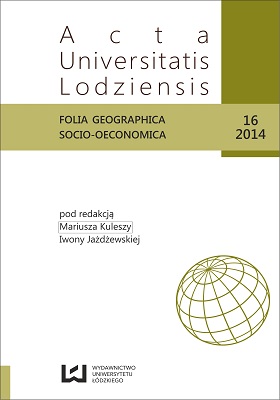The size and the shape of ground plots in Łódź
DOI:
https://doi.org/10.18778/1508-1117.16.09Keywords:
ground plots, spatial structure, municipal space, Łódź, GISAbstract
Identification at using tools GIS of the degree formed in market conditions of diversifying the spatial structure of ground plots according to their size and of the shape constituted the purpose of this work. At the beginning of 2013 the area of Łódź was divided in 133 547 of plots. As results of conducted examinations were established that spatial schedule of plots was characterized by a great changeability. The density of plots in geodetic units is a consequence of spatial diversifying the number of plots, growing generally in centripetal direction. Average area of plots in geodetic units of Łódź, made conditional among others on location them and conditions of the parceling out, extremely strongly is diversified. A vast area of the changeability of this area is connected with it (481‒98 199 m2 ). In the city a general tendency of the increase in the area of plots in centrifugal direction is seen, though the smallest plots don't focus in very central areas, only in their north and south surroundings which is rewarded all at the same time with the very large number of plots. From a point of view of organizations of the municipal space of Łódź numerous very small ground plots which it is hard rationally to develop or to sell constitute the peculiar problem. In individual spatial units also developing the biggest ground plots can be a substantial problem. Peculiarly the high level of the changeability of the area of plots characterizes the geodetic units located in the indirect zone, and to a lesser degree in the zone of peripheral Łódź. Examining the shape of plots in geodetic units was based on two rates. First from them determines diversifying of the shapes of plots, however second expresses the step, in which the real shape of plots differs from the circle. The distribution of the value of the indicator of diversifying the shape of plots in spatial units is almost perfectly symmetrical, about the average dispersion and strong kurtosis. This distribution in great measure becomes a distribution of the number of plots like and depends on the density as well as size of plots. Diversifying the shapes of plots, being ahead of an average level in the city, appears mainly in the geodetic units in the central and indirect zone. Peripheral agricultural areas, locate above all in the eastern part of the city are characterized by little adding variety to this shape. Second from applied indicators of the shape of plots, depicting their cohesion he doesn't show the great diversity in the municipal space and won't depend on the density and size of plots. Above all locate plots in peripheral areas demonstrate the low cohesion, but also in the city centre zone. Plots located as a rule in the indirect zone have the shape most similar to the circle. Based on values of both considered rates of the shape of plots four distinguished types of spatial units stayed.
References
Conzen M.P., 2002, From Alnwick to Cincinnati: Teasdale property cycles in Old World and the New, „Urban Morphology”, 6(1).
Google Scholar
Conzen M.R.G., 1960, Alnwick, Northumberland. A study in town-plan analysis, The Institute of British Geographers, Publication, 27
Google Scholar
DOI: https://doi.org/10.2307/621094
Dzieciuchowicz J., 2011, Środowisko mieszkaniowe wielkiego miasta. Przykład Łodzi, Wydawnictwo UŁ, Łódź.
Google Scholar
Jażdżewska I., 1999, Przemiany funkcjonalne i morfologiczne przestrzeni geograficznej wsi Rzgów w świetle metod numerycznych, ŁTN, Łódź.
Google Scholar
Kopczewska K., 2008, Renta geograficzna a rozwój społeczno-gospodarczy, CeDeWu, Warszawa.
Google Scholar
Kostrubiec B., 1972, Analiza zjawisk koncentracji w sieci osadniczej, „Prace Geograficzne IG PAN”, 93.
Google Scholar
Koter M., 1969, Geneza układu przestrzennego Łodzi przemysłowej, „Prace Geograficzne IG PAN”, 79.
Google Scholar
Koter M., 1974, Fizjonomia, morfologia i morfogeneza miasta. Przegląd rozwoju oraz próba uściślenia pojęć, „Zeszyty Naukowe Uniwersytetu Łódzkiego”, Ser. II, z. 55.
Google Scholar
Koter M., 1979, Struktura morfogenetyczna wielkiego miasta na przykładzie Łodzi, „Acta Universitatis Lodziensis”, Ser. II, z. 21.
Google Scholar
Koter M., 1994, Od fizjonomii do morfogenezy i morfologii porównawczej. Podstawowe zagadnienia teoretyczne morfologii miast, [w:] Koter M., Tkocz J. (red.), Zagadnienia geografii historycznej osadnictwa w Polsce, Materiały konferencyjne, UMK, UŁ, Toruń‒Łódź.
Google Scholar
Kotlicka J., 2008, Przemiany morfologiczne terenów przemysłowych Łodzi, ŁTN, Łódź.
Google Scholar
Liszewski S., 1977, Tereny miejskie a struktura przestrzenna Łodzi, „Acta Universitatis Lodziensis”, UŁ, Łódź
Google Scholar
Liszewski S., 1979, Zróżnicowanie przestrzenne użytkowania ziemi w Łodzi, „Acta Universitatis Lodziensis”, Ser. II, Folia Geographica, 21.
Google Scholar
Liszewski S., 1997, Przemiany funkcjonalne i przestrzenne terenów przemysłowych Łodzi, „Zeszyty Instytutu Geografii i Przestrzennego Zagospodarowania PAN”, 47, Aglomeracje miejskie w procesie transformacji, VI.
Google Scholar
Miszewska B., 1979, Elementy struktury morfologicznej Wrocławia, „Acta Universitatis Wratislaviensis”, 438, Prace Instytutu Geograficznego, ser. B, Geografia Społeczno-Ekonomiczna, t. 3.
Google Scholar
Miszewska B., 1994, Bloki urbanistyczne Wrocławia w różnych fazach cyklu miejskiego, [w:] Koter M., Tkocz J. (red.), Zagadnienia geografii historycznej osadnictwa w Polsce, Materiały konferencyjne, UMK, UŁ, Toruń‒Łódź.
Google Scholar
Miszewska B., 1996, Struktura morfologiczna peryferyjnych osiedli Wrocławia, „Acta Universitatis Wratislaviensis”, 1904, Prace Instytutu Geograficznego, ser. B, Geografia Społeczno-Ekonomiczna, nr XIV.
Google Scholar
Piech M., 2004, Przemiany funkcjonalne terenów przemysłowych w latach 1988‒1996 (w granicach kolei obwodowej), ŁTN, Łódź
Google Scholar
Downloads
Published
How to Cite
Issue
Section
License

This work is licensed under a Creative Commons Attribution-NonCommercial-NoDerivatives 4.0 International License.








